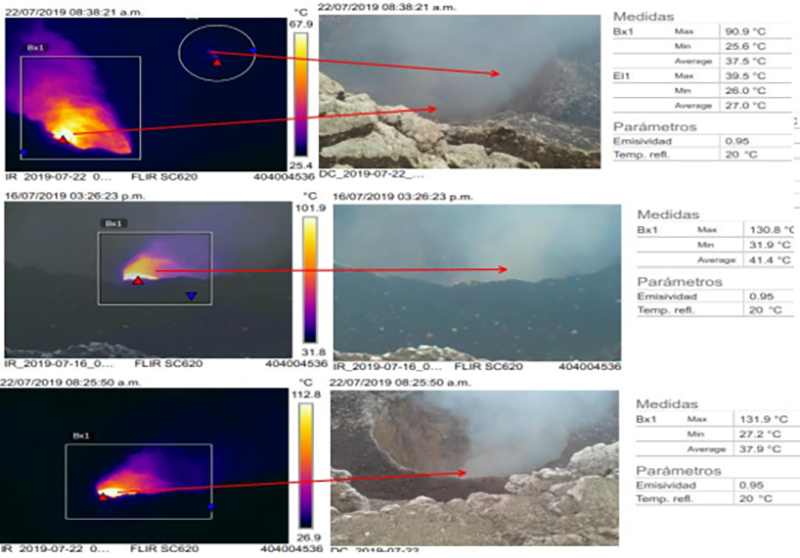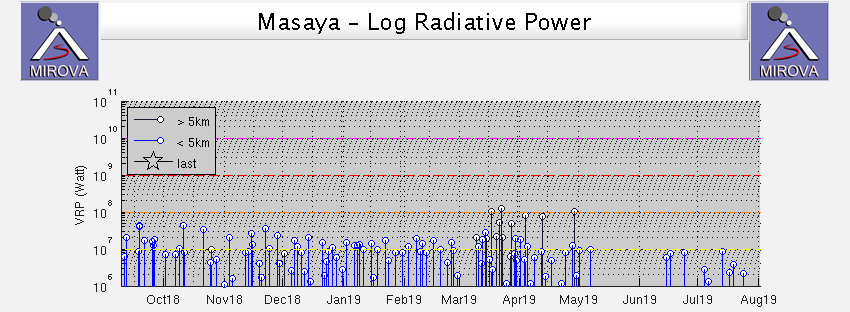Report on Masaya (Nicaragua) — August 2019
Bulletin of the Global Volcanism Network, vol. 44, no. 8 (August 2019)
Managing Editor: Edward Venzke.
Research and preparation by Kadie Bennis.
Masaya (Nicaragua) Lava lake activity declined during March-July 2019
Please cite this report as:
Global Volcanism Program, 2019. Report on Masaya (Nicaragua) (Venzke, E., ed.). Bulletin of the Global Volcanism Network, 44:8. Smithsonian Institution. https://doi.org/10.5479/si.GVP.BGVN201908-344100
Masaya
Nicaragua
11.9844°N, 86.1688°W; summit elev. 594 m
All times are local (unless otherwise noted)
Masaya, in Nicaragua, contains a lava lake found in the Santiago Crater which has remained active since its return in December 2015 (BGVN 41:08). In addition to this lava lake, previous volcanism included explosive eruptions, lava flows, and gas emissions. Activity generally decreased during March-July 2019, including the number and frequency of thermal anomalies, lava lake levels, and gas emissions. The primary source of information for this report comes from the Instituto Nicareguense de Estudios Territoriales (INETER).
On 21 July 2019 a small explosion in the Santiago Crater resulted in some gas emissions and an ash cloud drifting WNW. In addition to the active lava lake (figure 77), monthly reports from INETER noted that thermal activity and gas emissions (figure 78) were decreasing.
 |
Figure 77. Active lava lake visible in the Santiago Crater at Masaya on 27 June 2019. Photo by Sheila DeForest (Creative Commons BY-SA license). |
 |
Figure 78. Gas emissions coming from the Santiago Crater at Masaya on 29 June 2019. Photo by Sheila DeForest (Creative Commons BY-SA license). |
On 15 May and 22 July 2019, INETER scientists used a FLIR SC620 thermal infrared camera to measure temperatures of fumaroles on the Santiago Crater. In May 2019 the temperature of fumaroles had decreased by 48°C since the previous month. Between May and July 2019 fumarole temperatures continued to decline; temperatures ranged from 90° to 136°C (figure 79). Compared to May 2019 these temperatures are 3°C lower. INETER reports that the level of the lava lake has been slowly dropping during this reporting period.
According to MIROVA (Middle InfraRed Observation of Volcanic Activity) data from MODIS satellite instruments, frequent thermal anomalies were recorded from mid-March through early May 2019, with little to no activity from mid-May to July 2019 (figure 80). Sentinel-2 thermal images show high temperatures in the active lava lake on 10 March 2019 (figure 81). Thermal energy detected by the MODVOLC algorithm showed 14 hotspot pixels with the most number of hotspots (7) occurring in March 2019.
Geological Summary. Masaya volcano in Nicaragua has erupted frequently since the time of the Spanish Conquistadors, when an active lava lake prompted attempts to extract the volcano's molten "gold" until it was found to be basalt rock upon cooling. It lies within the massive Pleistocene Las Sierras caldera and is itself a broad, 6 x 11 km basaltic caldera with steep-sided walls up to 300 m high. The caldera is filled on its NW end by more than a dozen vents that erupted along a circular, 4-km-diameter fracture system. The Nindirí and Masaya cones, the source of observed eruptions, were constructed at the southern end of the fracture system and contain multiple summit craters, including the currently active Santiago crater. A major basaltic Plinian tephra erupted from Masaya about 6,500 years ago. Recent lava flows cover much of the caldera floor and there is a lake at the far eastern end. A lava flow from the 1670 eruption overtopped the north caldera rim. Periods of long-term vigorous gas emission at roughly quarter-century intervals have caused health hazards and crop damage.
Information Contacts: Instituto Nicaragüense de Estudios Territoriales (INETER), Apartado Postal 2110, Managua, Nicaragua (URL: http://www.ineter.gob.ni/); MIROVA (Middle InfraRed Observation of Volcanic Activity), a collaborative project between the Universities of Turin and Florence (Italy) supported by the Centre for Volcanic Risk of the Italian Civil Protection Department (URL: http://www.mirovaweb.it/); Hawai'i Institute of Geophysics and Planetology (HIGP) - MODVOLC Thermal Alerts System, School of Ocean and Earth Science and Technology (SOEST), Univ. of Hawai'i, 2525 Correa Road, Honolulu, HI 96822, USA (URL: http://modis.higp.hawaii.edu/); Sentinel Hub Playground (URL: https://www.sentinel-hub.com/explore/sentinel-playground); Sheila DeForest (URL: https://www.facebook.com/sheila.deforest).




